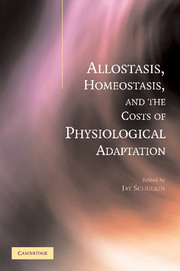Book contents
- Frontmatter
- Dedication
- Contents
- Preface
- Contributors
- Introduction
- 1 Principles of Allostasis: Optimal Design, Predictive Regulation, Pathophysiology, and Rational Therapeutics
- 2 Protective and Damaging Effects of the Mediators of Stress and Adaptation: Allostasis and Allostatic Load
- 3 Merging of the Homeostat Theory with the Concept of Allostatic Load
- 4 Operationalizing Allostatic Load
- 5 Drug Addiction and Allostasis
- 6 Adaptive Fear, Allostasis, and the Pathology of Anxiety and Depression
- 7 A Chronobiological Perspective on Allostasis and Its Application to Shift Work
- 8 Allostatic Load and Life Cycles: Implications for Neuroendocrine Control Mechanisms
- Commentary: Viability as Opposed to Stability: An Evolutionary Perspective on Physiological Regulation
- Index
7 - A Chronobiological Perspective on Allostasis and Its Application to Shift Work
Published online by Cambridge University Press: 05 February 2015
- Frontmatter
- Dedication
- Contents
- Preface
- Contributors
- Introduction
- 1 Principles of Allostasis: Optimal Design, Predictive Regulation, Pathophysiology, and Rational Therapeutics
- 2 Protective and Damaging Effects of the Mediators of Stress and Adaptation: Allostasis and Allostatic Load
- 3 Merging of the Homeostat Theory with the Concept of Allostatic Load
- 4 Operationalizing Allostatic Load
- 5 Drug Addiction and Allostasis
- 6 Adaptive Fear, Allostasis, and the Pathology of Anxiety and Depression
- 7 A Chronobiological Perspective on Allostasis and Its Application to Shift Work
- 8 Allostatic Load and Life Cycles: Implications for Neuroendocrine Control Mechanisms
- Commentary: Viability as Opposed to Stability: An Evolutionary Perspective on Physiological Regulation
- Index
Summary
INTRODUCTION
Allostasis, or stability through change, refers to a model of physiological regulation proposed by Sterling and Eyer (1988) to account for epidemiological data linking contemporary patterns of morbidity and mortality to a range of psychosocial conditions characterized as involving disruptions of intimate social relationships. Thus, marital dissolution, bereavement, unemployment, migration, and stressful work conditions are all associated with increased age-specific mortality rates (Sterling and Eyer, 1981, 1988). Importantly, the higher mortality rates are from virtually all leading causes of death, including cardiovascular disease, diabetes, and cancer, as well as accidents and suicide. Recent studies have confirmed and extended these findings. For example, data reviewed by McEwen (2000a) show clear negative relationships between the prevalence of hypertension, cervical cancer, osteoarthritis, and chronic disease on one hand, and socioeconomic status on the other, as well as differences in the prevalence of mood and anxiety disorders and of substance abuse related to income and education gradients.
These social and psychological factors all result in chronic arousal, or stress. Stressful stimuli represent real or perceived threats to the integrity of the organism, and they elicit a set of coordinated neuroendocrine responses that serve to prepare the organism to meet the challenge and to defend homeostasis. The responses are initiated by the sympathetic nervous system and the hypothalamic-pituitary-adrenocortical (HPA) axis, which trigger widespread changes in cardiovascular, metabolic, and immune parameters. These adaptive changes are normally reversed after removal of the arousing stimulus, but under conditions of repeated or chronic stress, they can persist for extended durations and may even become irreversible. Thus, the central principle of allostasis is that “to maintain stability an organism must vary all the parameters of its internal milieu and match them appropriately to environmental demands” (Sterling and Eyer, 1988, p. 636).
As an illustration of allostasis, Sterling and Eyer (1988) presented two continuous 24-hour records of arterial blood pressure, one from a normotensive and one from a hypertensive subject.
- Type
- Chapter
- Information
- Publisher: Cambridge University PressPrint publication year: 2004
- 8
- Cited by

